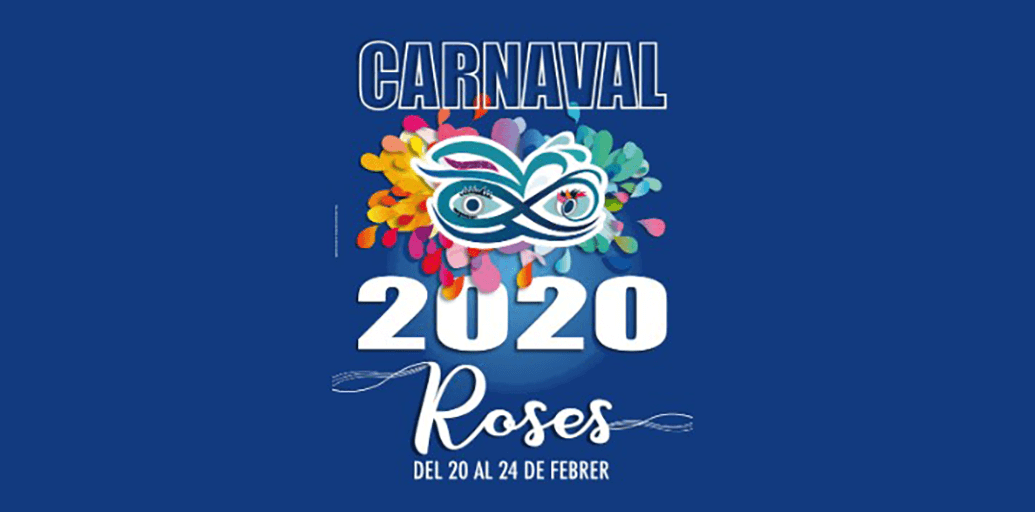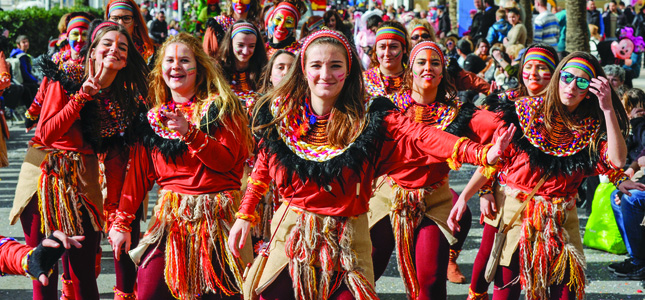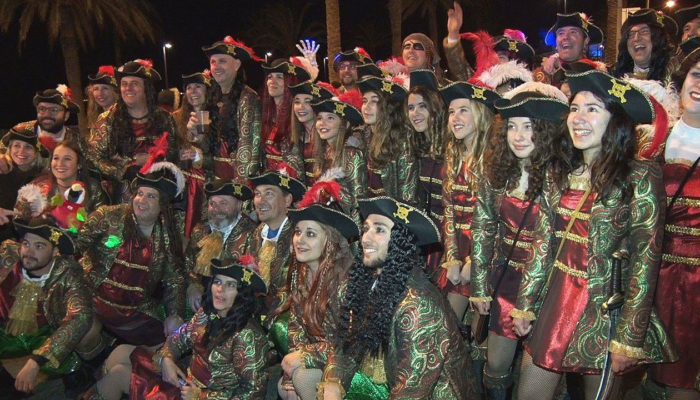Carnaval History Rosas (Roses in Catalan)

The Roses carnival is one of the areas of local life that incorporates a greater symbolic and emotional load. In recent decades, local essentialism has become a commonplace, almost without margins, for rational or emotional dissent. We said it a few years ago: "... It is the holiday most appreciated by rosincs, irrevocable and beloved, felt as the most personal thing, personal and non-transferable, full of nostalgia and memories." The carnival, therefore, points directly to the most sensitive fiber of many rosinques and rosincs. Undeterred, the identification between the Roses and the carnival subjects has become total, absolute. Clearly, there has been a desire to foster this party because, in the end, it has served to unite the community in a time when it was especially necessary to redo and / or strengthen the collective identity. of the population in front of a modern and different world and, of another one and consequently, to become one more a way of integration of the newcomer social sectors that, from the 60 years, and with the development of the tourism, have transformed the social reality of Roses.
If we understand the centrality of the carnival celebration in local life, we will also understand the need for a sociological and historical reflection that allows us to explain and understand how to reach this centrality that we discussed. Any social creation becomes a symbolic manifestation when it responds to certain specific purposes, socially shared, or when it is likely to meet the ideological expectations of the dominant social groups, which use it for the benefit of a particular social and political project or, at least, they are forced to swallow it into their mental magma and manipulate it to finally use it in a concrete, material way. In this way, some collective experiences are dismissed - their purpose is not important or relevant, or they do not have characteristics that could help reinforce the community traits that are to be strengthened at that historical moment - while others survive the passage. of time and they acquire a meaning that goes beyond the limits for which they were created. In short, they have demonstrated community functionality.
The Roses carnival does not escape a sociological review either. The carnival phenomenon in Roses is a good example of this transformation we talked about, of a social manifestation that has ended up incorporating an important symbolic burden. The carnival has become a local tradition. The question is to analyze how this tradition was created and where it came from. Is it an ex-novo creation or, on the contrary, does it sink its roots in history? From this point of view the key question is to value the historical tradition of this festival. It seems politically clear that he has been interested in maintaining a certain view of the Roses carnival: historically ancient, socially powerful, ideologically justifiable and tourist-friendly. At other times, for example, the carnival has served to maintain a quota of rebellion before the authorities, like a Gallic town before the Roman troops. Just think of the challenge posed by celebrating the carnival in 1939 or 1940, in a repressive and violent context unleashed by the recent Francoist military victory. The carnival, beyond the party, has had a social and political utility, which has also been changing over time.
This process - from simple recreational activity to the basic creation of a community's identity - has been articulated over time, in a far-reaching historical evolution. Historical news about the carnival in Roses is not numerous, so much archival research will still need to be done to find out more about this festival in our town. This first finding is an indication, per se, of the low importance that the carnival must have had in Roses, comparable to that of other towns in the area. Its presence in the documentation seems to be commensurate with its social, community presence. The emptying of the Roses notarial books which is currently being carried out has brought some interesting references. So, for example, on August 22, 1616, Fra Onofre Cervera, monk and pieter of the monastery of Sant Pere de Rodes, and Pere Cervera [minor], a fisherman in the Selva de Mar, confessed that they owed Pere Raola de la Martre, a farmer from the town of Roses, brother-in-law of the second, 15 and 135 pounds of Barcelona currency, respectively. They had donated to their stepdaughter and sister, respectively, Old Cervera, daughter of Pere Cervera [major], also a fisherman in the Selva de Mar, and Margarita, his wife, both deceased, and totaling 150 pounds. that Antigua had constituted a dowry with the bridal couple who had both signed before the underwritten notary. So far this notarial deed does not differ from many other acts among privates who were normally signed. However, Pere Cervera promised that he would pay £ 70 on the day of his marriage and the remaining £ 65 between that date and the same day next year, while Brother Onofre Cervera promised to give him £ 15. it was up to you to pay for the next carnival day.
It is only a dowry debit, but carnival appears as a reference date, in this case to settle a debt. It seems, therefore, that the carnival is a significant date in the local calendar, as it could be Christmas, Sant Joan, Sant Pere or Sant Miquel, special days in the feudal economic calendar. It is no big deal, especially if we compare, for example, the allegorical drawings at the carnival festivities that many writers - bored with their lonely work - carried out on the margins of notarial events. As it was said in the catalog of the exhibition The ninots of the scribe, organized by the Historical Archive of Girona in 1999, usually "represent activities and allegorical elements typical of those days before Lent ( people who cook meat, containers with wine ...) and representative characters of the party. In this sense we highlight the image of 'Capellut', drawn and repeatedly mentioned in the dates of the documents. " Highlight the wealth of dolls in the notarial instruments of Castelló d'Empúries, in 1392-1402, 1407, 1408 or, more recently, 1444-1445 to give just a few examples. Or, however, should this phenomenon of Castellón be attributed to its proximity to Roses? At present it is impossible to maintain this assumption: a thorough emptying of the documentation of the medieval and modern times is lacking and further research is lacking on the subject. Anyway, the first historical reference of the carnival in Roses has gone back 164 years. The 1616 carnival was a festival present in Roses. That's all right. But the bottom line is another: one single and indirect news is not enough to keep the existence of a carnival qualitatively different from the rest, of a carnival that has been erected as an identifying feature of the inhabitants of Roses .

We'll have to wait until February 9, 1780 to find out more about the Roses carnival. Indeed, the mayor of the town, Miquel Ferrer, complained about the attempt to ban carnival dancing by the military governor of Trinitat Castle, a man described as a pretentious and violent character. The narrative of the facts is the following: "Following his genius to send everything [of the governor], I determine and prevent the public Bayle in the Arrivals of the Villa in the days of Carnival. I sent on Sunday a Assistant to the Balyle to introduce himself, it did not seem to Bayle to play the role of Toy, much less for one who is not and has not been his superior. Neither did he seem to escape such a concurrence by responding that he told the Governor that if he needed help he would be provided with as many as he could, and he responded with the same answer to the Governor's Second Order when he was suddenly informed that he was on his way to the Bayle post. Twenty soldiers with an Lieutenant of the fixed company of that Square with their long Arms and pierced bayonet, having ordered to give each soldier twenty cartridges. Sinking to the Bayle with the news so bold, hopeful that there would be no attempt made by the governor, and that the fatal results could bring that town, with such a little thought-out process.
From the content of the document, it is clear that the carnival was celebrated regularly and normally each year. The place: the Raval de Roses, on the public square, that is, in the Punta district, the sector with the most popular settlement. On the other hand, the mayor's ability to organize a spontaneous force of 24 men (the Rosinca population at that time was 1,952 in 1787, according to the Floridablanca census) seems to indicate an influx to the carnival sufficiently. However, the context of the document - the denunciation of the behavior of the military governor of the Castle of Trinidad - does not allow to deduce what was the social magnitude of the party, which, we suppose, must have been significant, given the outrage that aroused among the population the threat of suspension. It is also seen how the community does not hesitate to defend its party and its collective dignity. Despite the official or administrative context of the document, there are some important features to be considered in defining the importance of the carnival: the integration of the festival into community life, the number of attendees, the place ...
Already in the nineteenth century, there is still some other scattered news. On February 19, 1879, Julian Burgos and Antonio de Acuña, officials of the Administration of Customs of Roses, self-qualified of Gran Ulema and Gran Vizier, respectively, addressed the local landowner Miquel Coll i Caritg requesting them. the following: "We apologize that we interrupt your tranquility on your retirement and make V. the first echo of the next carnival. / Having need for the masquerade that prepares a Tílburi with its corresponding cavalry and knowing that V. can provide one and another, we will be grateful to you at our disposal for Thursday or tomorrow at noon on the date we in exchange for this gift will ask Muhammad our prophet to grant him two or three thousand huries in that little paradise. tell us if we can wait for what we ask and case of the affirmative, we will send tomorrow in due time for it./ Only to offer you a thousand advance thanks are your loving servers and am igos. "This document is interesting because it moves away from the public domain. It is a private communication, which was not intended to be known by the social group and, therefore, freed from the artificial affectation that dominates human relations. The humorous complicity of the carnival is noticeable, the reversal of values and roles is present. Ball masquerade dominates the party, a trait that had previously appeared; the appearance of the reference to the hurís (the Dictionary of the Catalan Language of the Institute of Catalan Studies defines hurí like "any of the beautiful women and always virgin imagined to exist in the paradise of Muhammad like companions of the blessed ones ") Transports us to the sensuality that unmasks the party, to the sexual freedom imagined for a few days. These are new features that we must add to the previous references. Is the carnival getting older? We still don't know. We continue to have too few news. However, there is some hint that may make us suspect.
Indeed, on January 17, 1914, the City Council of Roses stipulated what public shows should be - cinematograph, public ballroom dances and concerts - that had to satisfy the municipal arbitrations and the amount that had to be paid , is recorded with two pesetas "... the public dances that occur in carnival time also for each day ...", exactly twice as much as any other normal function. It seems the carnival is a significant enough show to be recorded at a higher rate than most other local shows. More party, more taxes. Economic logic leaves no doubt. There seems to be a trend going on: The carnival is being organized as an unmissable party on the rosinc calendar. A very significant episode occurs in 1939, the year of the final defeat of the republican democratic regime. A Francoist Management Commission hiding behind a hesitant Recreational Union Fraternal Union, which had not been legalized, had been trying to celebrate the carnival since 1939, at least considering the energetic telegram sent by the civil governor, Antonio Federico. of Correa Veglison, to the Town Hall of Roses: "As they come to my news, it is deduced that in this town it is intended to hold dances and carnival parties, remind [the] circular [of] this Government ... by which [ Mr.] Minister [of] the Government maintains [the] absolute suspension [of] those parties, being strictly prohibited not only the [acts] that were usually held [on the public road], but also [company] or company parties, of so that the expressed days go unnoticed ... " It seems clear, first, that Roses had been preparing for the carnival since 1939, as it had traditionally done; but it is also clear that the SUF is involved in the development of the events of this party. In this sense, the City Council reminded, in March 1941, of the president of the SUF, that public shows "... must end at twelve o'clock at midnight, but at this time it cannot be public inside the premises ..." , a warning that most likely also has to do with carnival celebration. In this difficult political context the celebration of the carnival celebrations becomes a clear sign of its social power. Neither the wounds of the Civil War, nor the political repression that was raging over the country, could stop the community's impulse to celebrate a party incardinated in the essence of the population.
This increasing importance of the carnival should not be overlooked that the local big party was still the Festa Major, in August, which became the annual meeting place for all the citizens of Roses. The City Council was making the most of its economic efforts to have good tables, to clean the square, to organize all the parallel events with the maximum possible glare. By comparison, the carnival was clearly in the background. However, the economic and social transformations begun in the 1960's with the advent of mass tourism, reversed the correlation of forces. Given the impossibility of the citizens of Roses to enjoy the events of the Festa Major, an alternative party was being imposed, in winter, which could fulfill the community function of gathering the neighborhood around a party. It was not necessary to invent it, it was not necessary to resort to a replacement saint: the festival already existed and also had a well-established historical tradition. It was the carnival. Since then, the Roses carnival has progressively fulfilled the functions performed by the Festa Major, thus ensuring entry into the essentialist complex of the population. Roses is carnival, carnival is Roses.
In short, an attempt has been made to demonstrate the existence of a long carnival tradition in Roses, at least since the beginning of the 17th century, from 1616 onwards, thanks to the scandalous news that has been compiled. Certainly, with time and investment in research, many others will appear. However, it is too early to affirm the special and relevant nature of the carnival festivities before the process of replacing the community functions performed by the Summer Festival for the carnival. No assumptions need to be ruled out, but the obscure and thankless job of working the archives first will have to be done.
Please complete the form by clicking below and our advisers will get back to you as soon as possible to discuss your project.
You can also contact us at +34 872 268 850








